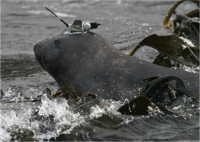
Over 800,000 vertical profiles of Temperature and Salinity have been collected since 2004 in the World Ocean by attaching tags on marine mammals, such as Southern elephant seals.
In this website, you will find information about the marine mammal tagging programs, and an access point to the publicly available databases.
Please let us know if you are using our data. You can contact us by mail to info@meop.net if you have any question.
The MEOP data portal
Content of the website
Instrument attachment
Seals
The seals are trapped in nets, caught in traps or immobilized using an injection rifle. These methods have been evaluated and are used for catching seals all over the world. Captured seals are handled with care, measured and tagged, and released within about an hour. Once deployed, the tags will remain for a maximum of one year, depending on the time of the next moulting. If the tag has not been recovered before the moult, it will simply fall off the animal.
The instruments do not significantly affect at-sea behaviour of seals given that (i) the combined weight of the tags and glue is 0.5 kg i.e. maximum 0.15% of the mean departure weight of a seal, (ii) small, instrumented seals weighing 169 kg (instrument <0.3% of the seals' weight) were unaffected in either the short-term (growth rates) or the long-term (survival) by carrying these instruments (McMahon et al. 2008). The studies all comply with the strict Animal Ethics requirements of the corresponding national animal ethics committees.
Whales
Belugas or Narwhals have been instrumented with oceanographic devices in a number of occasions. They are generally captured in shallow waters, by placing a hoop net over their heads and around their pectoral fins. The tag is then attached to the dorsal ridge of the animals by means of a "saddle" of pliable material, and a few nylon pins which migrate out of the tissue after a few months, releasing the package (e.g. Laidre et al. 2010).
Sea turtles
Although sea turtles are not precisely marine mammals, they are obviously welcome on the MEOP data portal. For the tags deployed by Damien Chevallier in French Guiana, the attachment procedure was performed during night-time egg laying, i.e. at the only moment when individuals are static, using a red light to minimize disturbance (Chambault et al. 2015). The carapace was cleaned with scrapers, water and acetone, then the tags were fixed on the carapace as close as possible to the head using an epoxy resin, with the antenna facing forward to ensure satellite transmission at sea during surface intervals. To allow the resin to dry completely, turtles were then herded into a pen and left there for approximately 2h before being released. During tag deployment, measurements of the Curved Carapace Length (CCL) were also taken.

